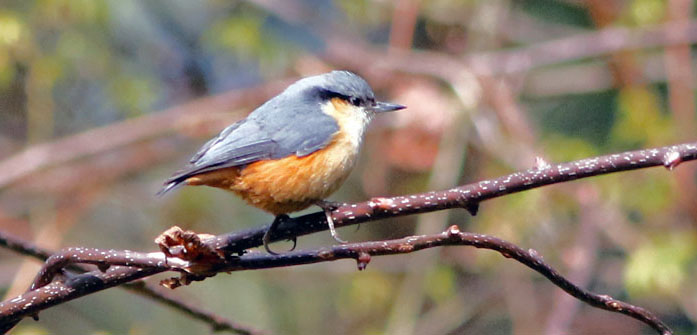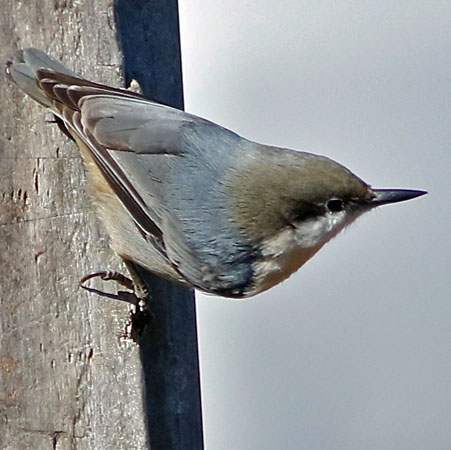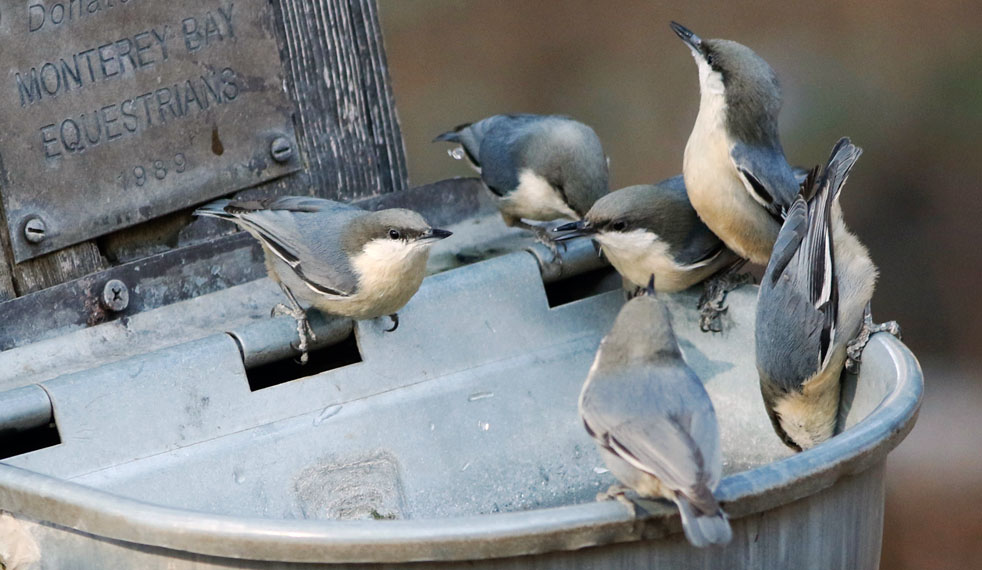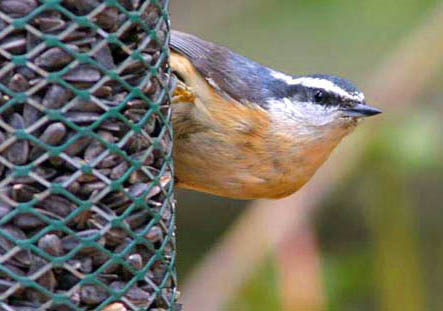| |
NUTHATCHES Sittidae |
- 27 species in northern Hemisphere
- DR personal total: 15 species (48%), 9 photo'd
|
 Nuthatches are a small family of tree-bark specialists found throughout the Holarctic. Taxonomically, they are related to northern creepers (Certhidae) and (more distantly) to the tits and chickadees (Paridae); see Barker et al. (2004). They are well-known for their habit of foraging head downwards, searching the bark on tree trunks and large limbs. They can easily cling upside down as they search for insects, grubs, and seeds. It is a familiar posture, as shown by this White-breasted Nuthatch (left). All the nuthatches are similar in shape and behavior, and "once one is familiar with one species, all the others will be instantly recognized as nuthatches" (Harrap & Quinn 1995). Indeed, they are all assigned to a single genus (Sitta). The body is small and compact. They have a sturdy, pointed bill and short legs with strong toes and long claws. The feet are "scansorial," specially adapted for climbing and clinging. Two species of rock nuthatches in Eurasia feed in a similar fashion on rock faces. Currently, pending future splits, there are four nuthatches in North America, 23 in Eurasia, and two in North Africa [Algerian Nuthatch S. ledanti, plus a race of Eurasian Nuthatch S. europaea resides in Morocco]. Nuthatches are a small family of tree-bark specialists found throughout the Holarctic. Taxonomically, they are related to northern creepers (Certhidae) and (more distantly) to the tits and chickadees (Paridae); see Barker et al. (2004). They are well-known for their habit of foraging head downwards, searching the bark on tree trunks and large limbs. They can easily cling upside down as they search for insects, grubs, and seeds. It is a familiar posture, as shown by this White-breasted Nuthatch (left). All the nuthatches are similar in shape and behavior, and "once one is familiar with one species, all the others will be instantly recognized as nuthatches" (Harrap & Quinn 1995). Indeed, they are all assigned to a single genus (Sitta). The body is small and compact. They have a sturdy, pointed bill and short legs with strong toes and long claws. The feet are "scansorial," specially adapted for climbing and clinging. Two species of rock nuthatches in Eurasia feed in a similar fashion on rock faces. Currently, pending future splits, there are four nuthatches in North America, 23 in Eurasia, and two in North Africa [Algerian Nuthatch S. ledanti, plus a race of Eurasian Nuthatch S. europaea resides in Morocco].
Perhaps the most lovely is the scare and local Beautiful Nuthatch (below). It is a large nuthatch of mature subtropical broadleaf forest with large, spreading epiphyte-laden trees. It is a little-studied species, and considered "vulnerable" as the world population is fewer than 10,000 birds (Harrop 2008). Most of these populations are in Bhutan, northeast India, adjacent Myanmar, and Laos. It is certainly the world's most sought-after nuthatch. |
 |
The Himalayas East Asia are the center of Sittidae distribution, with more than a dozen species. Beautiful Nuthatch lives in a subtropical zone, but most species are residents of coniferous or pine-oak woodlands. These range from:
- Eurasian Nuthatch (right), a mid-sized Palearctic nuthatch whose ranges encompasses Britain to Siberia, and south into China and Formosa. This individual was in a panda reserve in Shaanxi Province, at about 2000m (6500' elev) in a forest of oaks, pines, and bamboo. There are 22 subspecies (Harrop 2008); this should be sinensis;
- White-tailed Nuthatch (below), a small, short-billed, active nuthatch of temperate broadleaf and oak-evergreen forests, where it is a common component of mixed species flocks at mid-elevations in the Himalayas; and
- Przewalski's Nuthatch (below right), a white-faced, mid-sized nuthatch with cinnamon underparts that is endemic to central China. It is a comparatively recent split from White-cheeked Nuthatch S. leucopsis, of northern Pakistan and northwest India, on morphological and vocal differences. It is a little known and perhaps rare species (Harrap 2008). This one was photographed in spruce and birch forest at 2500m (8200' elev.) in Ganzu Province, China.
|
 |
 |
 |
|
|
There are several quite colorful nuthatches in tropical south Asia. The endemic Philippine nuthatch is Sulphur-billed Nuthatch (above left). It is a smallish species with yellow bill and eyering, violet-blue upperparts, and orangey underparts. It lives in pines and and evergreen forests up to 2600m (8500' elev.), and is most common at higher elevations.
Velvet-fronted Nuthatch (above right) has a bright red bill, black forehead, and violet-blue upperparts. It ranges from India through southeast Asia to Borneo, Sumatra, and Java, where it inhabits a variety of tropical rainforests, swamp-forests, and mixed pine-oak woodlands.
Giant Nuthatch S. magna, of pine forests from central China to Myanmar, is not only the world's largest nuthatch, but has blue-gray upperparts that contrast with bright rufous undertail coverts, and the latter has large white spots. The mid-sized Blue Nuthatch S. azurea of Peninsular Malaysia, Sumatra, and Java is strikingly black-and-white with a big pale eyering, and a lovely sky-blue patterns on the wings.
Some Old World nuthatches have very restricted ranges: White-browed Nuthatch S. victoriae is found only in the Chin Hills of w. Burma; Corsican Nuthatch S. whiteheadi is restricted to Corsica; and Algerian Nuthatch S. ledanti is known from only 4 sites in northeast Algeria (Harrop & Quinn 1995). Thus, although it is a small family and found almost entirely north of the Equator (some Indonesian populations of a couple species are south of the Equator), it is not at all easy to find all of the nuthatches. I'm not even half-way yet.
|
|
_3421.jpg) Red-breasted Nuthatch (above), of North America, summers in coniferous forests, including montane pine, fir, and spruce forests, and moves south or downslope in winter. In some years they stage very impressive winter flights into the lowlands and to the coast, where they may visit backyard feeders. This one (above left) spent the winter feeding on sunflower seeds in our backyard on the Monterey Peninsula. In some winters there are huge numbers calling "yank-yank-yank" in the pine woods, or gathering at water sources (above right). Yet in some winters there are none here at all. Red-breasted Nuthatch (above), of North America, summers in coniferous forests, including montane pine, fir, and spruce forests, and moves south or downslope in winter. In some years they stage very impressive winter flights into the lowlands and to the coast, where they may visit backyard feeders. This one (above left) spent the winter feeding on sunflower seeds in our backyard on the Monterey Peninsula. In some winters there are huge numbers calling "yank-yank-yank" in the pine woods, or gathering at water sources (above right). Yet in some winters there are none here at all.
In North America, White-breasted Nuthatch (right) is a familiar bird. It clings to rough-barked trees from the eastern deciduous forest to the oak woodlands of California and up into the western mountains in yellow-pine forests. Recent research in genetics and vocalizations suggest that White-breasted Nuthatch might be split into 3 species, and each species would more-or-less match the three woodland types enumerated. The individual hanging downwards at the top of this page is from the "Pacific" group; the one clinging to a pine in Arizona (right) is one of the "Interior West" group. Calls remain a primary way to separate these groups, but both calls and plumages are assess as identification tools in Mlodinow (2014). A good discussion of ranges in California, with maps, is in Pandolfino et al. (2017). |
 In addition, within North America, another set of nuthatches specialize in closed-cone pine forests. Brown-headed Nuthatch S. pusilla lives among the loblolly pine of the southeast, while Pygmy Nuthatch (left and below) thrives in the knobcone and related pine forests out west. In addition, within North America, another set of nuthatches specialize in closed-cone pine forests. Brown-headed Nuthatch S. pusilla lives among the loblolly pine of the southeast, while Pygmy Nuthatch (left and below) thrives in the knobcone and related pine forests out west.
In California there is a population of Pygmy Nuthatch in Monterey pine forests along the coast (the photographed bird is one of them) and a montane population in the Sierra Nevada and Rocky Mountains. These two populations have different calls. The ones on the coast sound to me like telegraph operations: dit-it dit did-it dit dit, etc. These nuthatches are quite small and have shorter bills used to pry among the closed cones of the pines. The birds are often seen high in the canopy, clinging to pine cones, and are restlessly on the move constantly in small family groups. All nuthatches nest in cavities, usually holes in trees. Pygmy Nuthatches in my back yard dig their own nest hole in the soft wood of dead pine trees. They have a cooperative breeding strategy that includes the paired adults and 1-3 young from previous broods (apparently young males; it is the young females that disperse). Nests with helpers have better breeding success than those without. The helpers join in feeding the young and defending the nesting territory (Roberson & Tenney 1993, Harrap & Quinn 1995). |
 |
| |
Photos: The White-breasted Nuthatch Sitta carolinensis, of the "Pacific" group, was at Lake Solano Park, Solano Co., California, on 15 Jan 2006. The Beautiful Nuthatch Sitta formosa was at Morong, Bhutan, on 18 Mar 2019. The Eurasian Nuthatch Sitta europaea was at Foping Nature Reserve, Shaanxi, China, on 12 Nov 2010. The White-tailed Nuthatch Sitta himalayensis was along Trashingang Rd., Bhutan, on 20 Mar 2019. The Przewalski's Nuthatch Sitta przewalskii was at Huzu NP, Ganzu, China, on 14 June 2004. The Sulphur-billed Nuthatch Sitta oenochlamys was above Hamut, Sierra Madres, northern Luzon, Philippines, on 3 Jan 2006. The Velvet-fronted Nuthatch Sitta frontalis was in Thap Lan NP, Thailand, on 27 Dec 2012. The feeder Red-breasted Nuthatch Sitta canadensis was in my Pacific Grove backyard, Monterey Co., California, on 2 Apr 2005; the two at a water source were in Jacks Peak Reg. Park, Monterey Co., California, on 28 Oct 2020. The second photo of White-breasted Nuthatch Sitta carolinensis, of the "Interior West" group, was at Patagonia, Arizona, on 2 May 2015. The single Pygmy Nuthatch Sitta pygmaea was at Sunset SB, Santa Cruz Co., California, on 15 Jan 2006; the half-dozen at a water source were in Jacks Peak Reg. Park, Monterey Co., California, on 28 Oct 2020.
All photos © Don Roberson; all rights reserved.
Family book: Rating 
Harrap, Simon, and David Quinn. 1995. Chickadees, Tits, Nuthatches & Treecreepers. Princeton Univ. Press, Princeton, N. J.
This is a solid addition to the family books in the Princeton series. The plates appear separately in the front. I found the artwork rather good in a "field guide" style (without much background) opposite summary pages which include small maps. The maps I looked at were quite good). Distinct races are nicely covered. The text cover identification, habitat, breeding biology (very summarized), relationships, and detailed plumage descriptions, plus references which (in contrast to other similar efforts) look reasonably extensive. I don't personally see the need for the detailed plumage descriptions since no book like this can hope to cover the complete range of variation, and they are very tedious to read, but it is the "style" of these family books. There are some helpful extra maps and sketches of plumage details scattered in the text. I was a bit put off by the use of Sibley & Ahlquist (1990) family taxonomy (since subject to criticism) and the unnecessary "lumping" of the penduline tits with the "true" tits. On the other hand, the authors recommend following Sibley & Monroe's (1990) species level split of Tufted and Black-crested titmice, and give a full explanation for their opinion. This sort of in-depth treatment is admirable. They failed to anticipate the split of Oak and Juniper titmice, although they do discuss that possibility, and do give detailed separate treatment to the differing vocalizations. It is the quality of the text that prompts me to give this a "four-star" rating, just about as high of a rating that I'll give to this type of family book.
Another good introduction to this family, by the same author as the family book, and with excellent photos, is in Harrap (2008).
Literature cited:
Barker, F.K., A. Cibois, P. Schikler, J. Feinstein, and J. Cracraft. 2004. Phylogeny and diversification of the largest avian radiation. Proc. Nat. Acad. Sci. 101: 11040–11045.
Harrop, S. 2008. Family Sittidae (Nuthatches), pp. 96–107 in Handbook of the Birds of the World (del Hoyo, J., A. Elliott & D.A. Christie, eds). Vol. 8. Lynx Edicions, Barcelona, Spain.
Mlodinow, S.G. 2014. Cryptic species: White-breasted Nuthatches. Birding 46: 26–32.
Pandolfino, E.R., K.P. Able, J.L. Dunn, and D. Lasprugato. 2017. Ranges of the subspecies of White-breasted Nuthatch in California. Western Birds 48: 26–34.
Roberson, D., and C. Tenney, eds. 1993. Atlas of the Breeding Birds of Monterey County, California. Monterey Audubon Soc., Carmel, CA.
Sibley, C.G., and B.L. Monroe, Jr. 1990. Distribution and Taxonomy of Birds of the World. Yale Univ. Press, New Haven, CT.
|
|
|










_3421.jpg) Red-breasted Nuthatch (above), of North America, summers in coniferous forests, including montane pine, fir, and spruce forests, and moves south or downslope in winter. In some years they stage very impressive winter flights into the lowlands and to the coast, where they may visit backyard feeders. This one (above left) spent the winter feeding on sunflower seeds in our backyard on the Monterey Peninsula. In some winters there are huge numbers calling "yank-yank-yank" in the pine woods, or gathering at water sources (above right). Yet in some winters there are none here at all.
Red-breasted Nuthatch (above), of North America, summers in coniferous forests, including montane pine, fir, and spruce forests, and moves south or downslope in winter. In some years they stage very impressive winter flights into the lowlands and to the coast, where they may visit backyard feeders. This one (above left) spent the winter feeding on sunflower seeds in our backyard on the Monterey Peninsula. In some winters there are huge numbers calling "yank-yank-yank" in the pine woods, or gathering at water sources (above right). Yet in some winters there are none here at all. In addition, within North America, another set of nuthatches specialize in closed-cone pine forests. Brown-headed Nuthatch S. pusilla lives among the loblolly pine of the southeast, while Pygmy Nuthatch (left and below) thrives in the knobcone and related pine forests out west.
In addition, within North America, another set of nuthatches specialize in closed-cone pine forests. Brown-headed Nuthatch S. pusilla lives among the loblolly pine of the southeast, while Pygmy Nuthatch (left and below) thrives in the knobcone and related pine forests out west. 